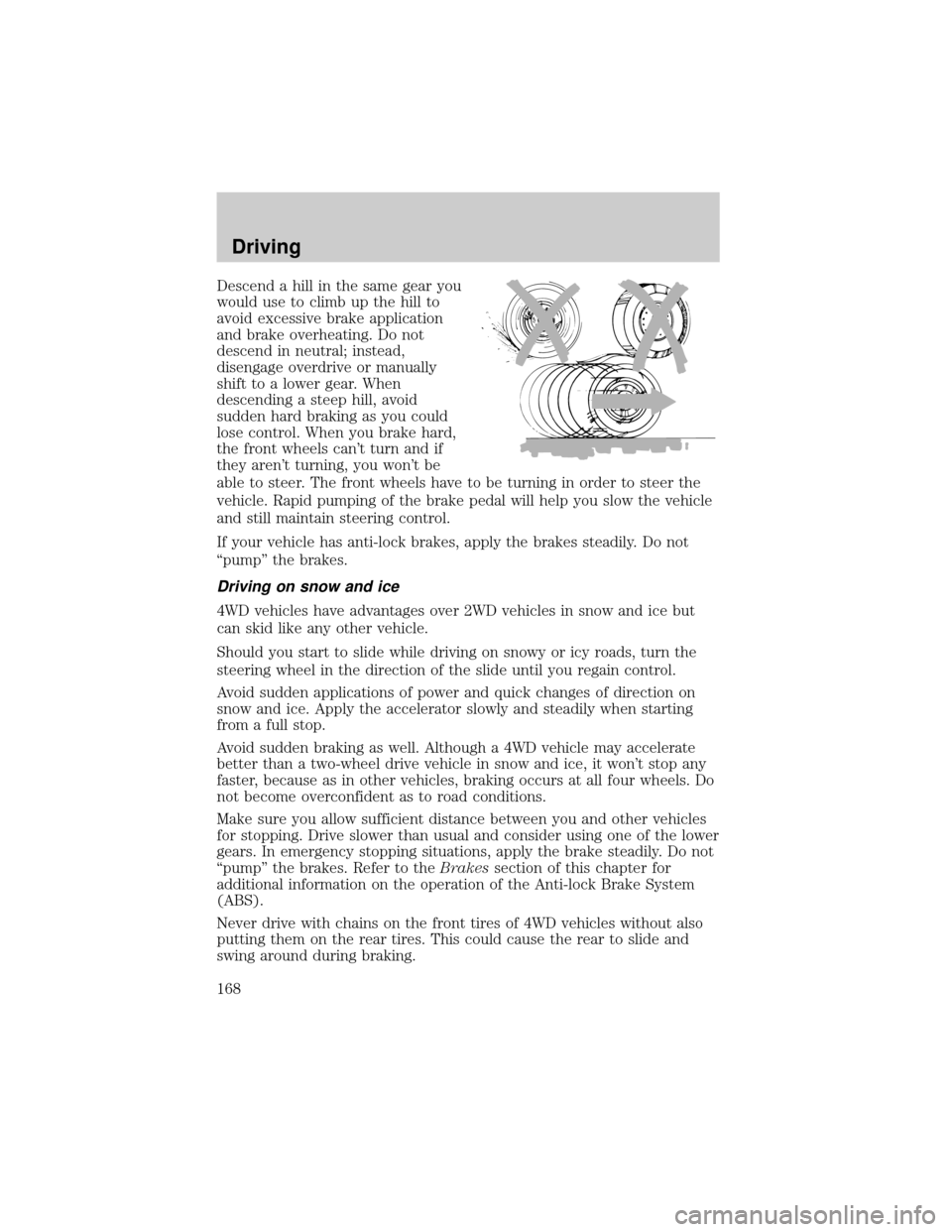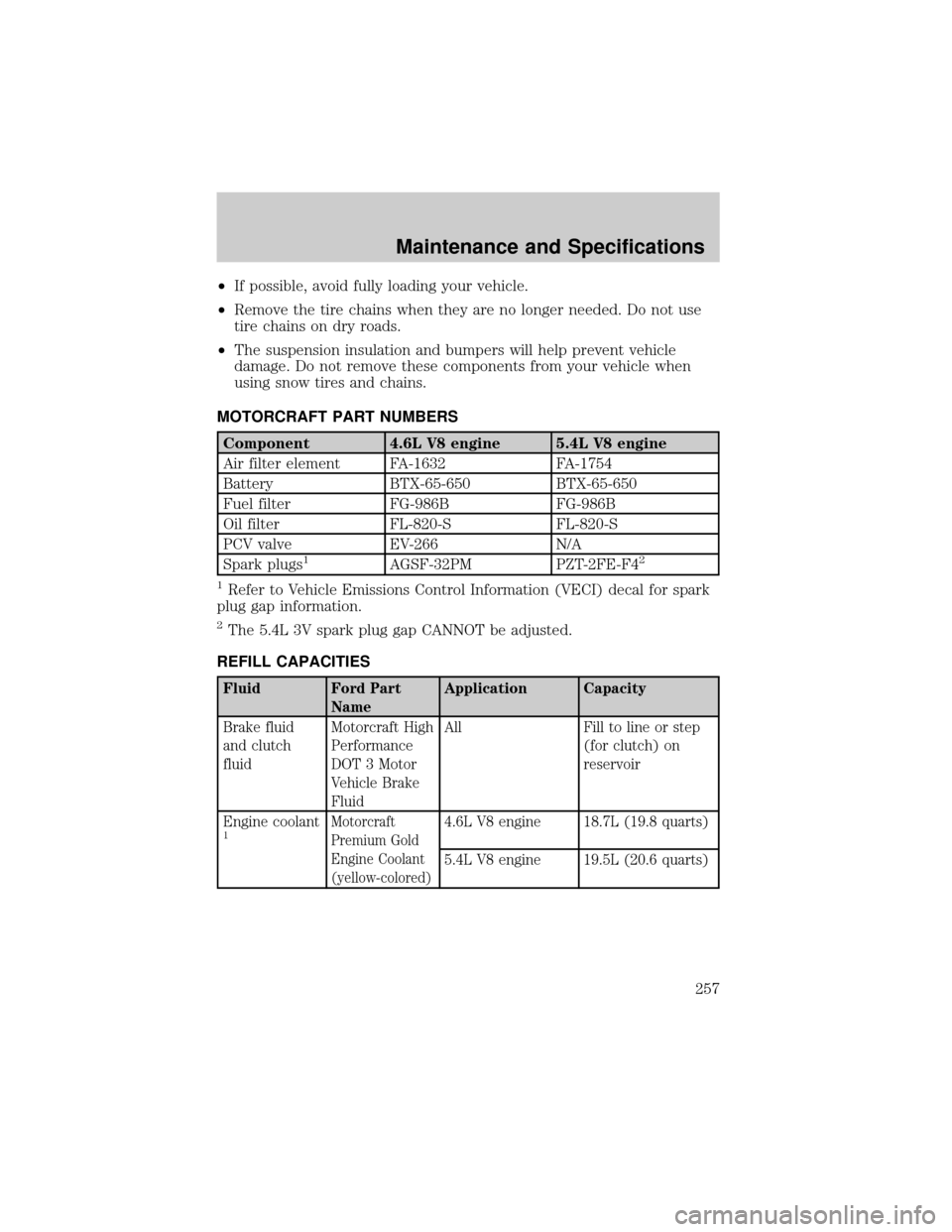snow chains FORD F150 2004 11.G Owners Manual
[x] Cancel search | Manufacturer: FORD, Model Year: 2004, Model line: F150, Model: FORD F150 2004 11.GPages: 280, PDF Size: 4.13 MB
Page 168 of 280

Descend a hill in the same gear you
would use to climb up the hill to
avoid excessive brake application
and brake overheating. Do not
descend in neutral; instead,
disengage overdrive or manually
shift to a lower gear. When
descending a steep hill, avoid
sudden hard braking as you could
lose control. When you brake hard,
the front wheels can't turn and if
they aren't turning, you won't be
able to steer. The front wheels have to be turning in order to steer the
vehicle. Rapid pumping of the brake pedal will help you slow the vehicle
and still maintain steering control.
If your vehicle has anti-lock brakes, apply the brakes steadily. Do not
ªpumpº the brakes.
Driving on snow and ice
4WD vehicles have advantages over 2WD vehicles in snow and ice but
can skid like any other vehicle.
Should you start to slide while driving on snowy or icy roads, turn the
steering wheel in the direction of the slide until you regain control.
Avoid sudden applications of power and quick changes of direction on
snow and ice. Apply the accelerator slowly and steadily when starting
from a full stop.
Avoid sudden braking as well. Although a 4WD vehicle may accelerate
better than a two-wheel drive vehicle in snow and ice, it won't stop any
faster, because as in other vehicles, braking occurs at all four wheels. Do
not become overconfident as to road conditions.
Make sure you allow sufficient distance between you and other vehicles
for stopping. Drive slower than usual and consider using one of the lower
gears. In emergency stopping situations, apply the brake steadily. Do not
ªpumpº the brakes. Refer to theBrakessection of this chapter for
additional information on the operation of the Anti-lock Brake System
(ABS).
Never drive with chains on the front tires of 4WD vehicles without also
putting them on the rear tires. This could cause the rear to slide and
swing around during braking.
Driving
168
Page 256 of 280

When replacing full size tires, never mix radial bias-belted, or
bias-type tires. Use only the tire sizes that are listed on the
Certification Label. Make sure that all tires are the same size, speed
rating, and load-carrying capacity. Use only the tire combinations
recommended on the label. If you do not follow these precautions,
your vehicle handling may be affected which can lead to loss of vehicle
control, vehicle rollover and/or personal injury.
Make sure that all replacement tires are of the same size, type,
speed rating, load-carrying capacity and tread design (e.g., ªAll
Terrainº, ªTouringº, etc.), as originally offered by Ford.
Do not replace your tires with ªhigh performanceº tires or larger
size tires.
Failure to follow these precautions may adversely affect the
handling of the vehicle, and increase the risk of loss of vehicle
control, vehicle rollover and/or personal injury.
Tires that are larger or smaller than your vehicle's original tires may also
affect the accuracy of your speedometer.
SNOW TIRES AND CHAINS
Snow tires must be the same size and grade as the tires you
currently have on your vehicle.
The tires on your vehicle have all weather treads to provide traction in
rain and snow. However, in some climates, you may need to use snow
tires and chains. If you need to use chains, it is recommended that steel
wheels (of the same size and specifications) be used, as chains may chip
aluminum wheels.
Follow these guidelines when using snow tires and chains:
²Use only SAE Class S chains.
²Install chains securely, verifying that the chains do not touch any
wiring, brake lines or fuel lines.
²Drive cautiously. If you hear the chains rub or bang against your
vehicle, stop and re-tighten the chains. If this does not work, remove
the chains to prevent damage to your vehicle.
Maintenance and Specifications
256
Page 257 of 280

²If possible, avoid fully loading your vehicle.
²Remove the tire chains when they are no longer needed. Do not use
tire chains on dry roads.
²The suspension insulation and bumpers will help prevent vehicle
damage. Do not remove these components from your vehicle when
using snow tires and chains.
MOTORCRAFT PART NUMBERS
Component 4.6L V8 engine 5.4L V8 engine
Air filter element FA-1632 FA-1754
Battery BTX-65-650 BTX-65-650
Fuel filter FG-986B FG-986B
Oil filter FL-820-S FL-820-S
PCV valve EV-266 N/A
Spark plugs
1AGSF-32PM PZT-2FE-F42
1
Refer to Vehicle Emissions Control Information (VECI) decal for spark
plug gap information.
2The 5.4L 3V spark plug gap CANNOT be adjusted.
REFILL CAPACITIES
Fluid Ford Part
NameApplication Capacity
Brake fluid
and clutch
fluidMotorcraft High
Performance
DOT 3 Motor
Vehicle Brake
FluidAll Fill to line or step
(for clutch) on
reservoir
Engine coolant
1Motorcraft
Premium Gold
Engine Coolant
(yellow-colored)4.6L V8 engine 18.7L (19.8 quarts)
5.4L V8 engine 19.5L (20.6 quarts)
Maintenance and Specifications
257
Page 279 of 280

Specification chart,
lubricants ...........................261, 263
Speed control ..............................61
Starting your
vehicle ........................144±145, 148
jump starting ..........................201
Steering wheel
controls ......................................64
tilting .........................................53
T
Tailgate ..................................79±80
Temperature control
(see Climate control) .................32
Tilt steering wheel ......................53
Tires ...........................195, 253±254
changing ..................195±197, 201
checking the pressure ............254
replacing ..................................255
rotating ....................................255
snow tires and chains ............256
tire grades ...............................254
treadwear ................................253
Towing .......................................173
recreational towing .................182
trailer towing ..........................173
Traction-lok rear axle ...............151
Transfer case
fluid checking .........................250
Transmission .............................151brake-shift interlock
(BSI) ................................151±152
fluid, checking and adding
(automatic) .............................248
fluid, refill capacities ..............257
lubricant specifications ..261, 263
Trunk ...........................................83
Turn signal ..................................45
V
Vehicle dimensions ...........263, 268
Vehicle Identification Number
(VIN) ..........................................268
Vehicle loading ..........................171
camper bodies ........................206
Ventilating your vehicle ...........148
W
Warning lights (see Lights) .......10
Washer fluid ..............................226
Water, Driving through .............170
Windows
power .........................................58
power down back window .......58
Windshield washer fluid and
wipers ..........................................52
checking and adding fluid .....226
replacing wiper blades .............52
Index
279